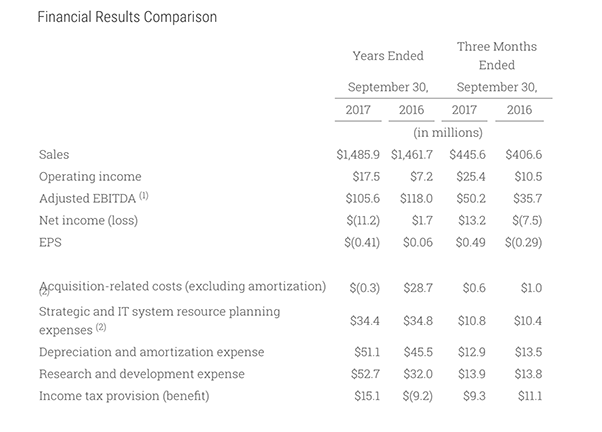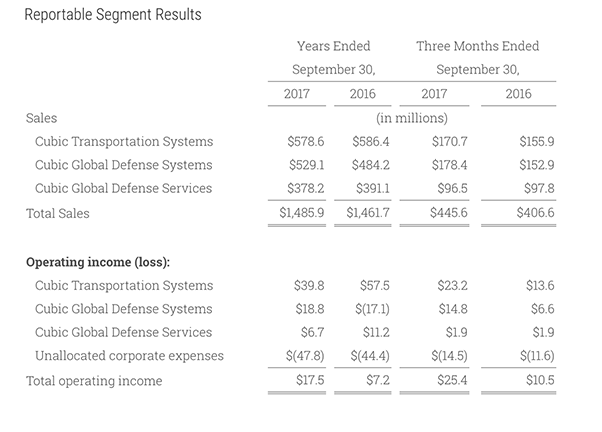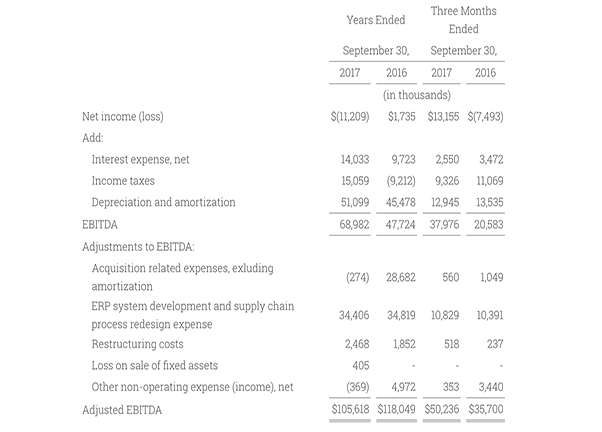- Record annual and quarterly sales of $1.486 billion for FY17 and $445.6 million for Q4.
- Adjusted EBITDA(1) of $105.6 million for fiscal FY17 and $50.2 million for Q4.
- Net loss of $11.2 million or $0.41 per share for FY17, and net income of $13.2 million or $0.49 per share for Q4.
- Total backlog of $3.104 billion as of September 30, 2017.
- Sales guidance for FY18 of $1.51 billion to $1.56 billion; Adjusted EBITDA(1)(2) guidance of $110 million to $135 million(3).
San Diego — November 20, 2017 — Cubic Corporation (NYSE: CUB) today announced its financial results for the fourth quarter and fiscal year ended September 30, 2017.
“We are very pleased by our strong fourth quarter performance with record sales, near-record Adjusted EBITDA and strong order intake. With the recent New York Metropolitan Transportation Authority contract win, we now have the highest backlog in the company’s history and are well positioned to deliver strong organic growth,” said Bradley H. Feldmann, president and chief executive officer of Cubic Corporation. “Our investments, innovation and overall strategy are paying off for our customers, shareholders and employees.”

(1) Adjusted EBITDA is a non-GAAP financial measure - see the section titled “Use of Non-GAAP Financial Information” for additional information regarding this non-GAAP financial measure.
(2) See the section below titled “Use of Non-GAAP Financial Information” for a description of the composition of these items.
(3) Guidance assumes a constant currency basis with fiscal year 2017.
Cubic had record annual and quarterly sales of $1.486 billion for fiscal 2017 and $445.6 million for the fourth quarter. On a constant currency basis, fiscal 2017 sales grew 3.0 percent compared to the prior year. Fiscal 2017 sales were impacted by $19.9 million of foreign currency exchange rate headwinds compared to fiscal 2016.
The increase in operating income in the fourth quarter and full year of fiscal 2017 was supported by higher sales. Operating income for the full fiscal year was further positively impacted by a reduction in general and administrative expenses, primarily attributable to the decrease in acquisition-related expenses. The increases in operating income for the fourth quarter and full fiscal year were partially offset by significant acceleration of investment in research and development (R&D) activity in fiscal 2017.
The changes in Adjusted EBITDA for the fourth quarter and full fiscal year are primarily attributable to the same matters noted above that impacted operating income, with the exception of the reduction in acquisition-related expenses, as acquisition-related expenses are excluded from the calculation of Adjusted EBITDA. The most significant matter that caused the decrease in Adjusted EBITDA from fiscal 2016 to 2017 was a $20.7 million relative increase in R&D investment.
The change in net income was primarily caused by the change in the effective tax rate. Cubic’s income tax provision totaled $15.1 million for fiscal 2017, compared to an income tax benefit of $9.2 million in fiscal 2016. The tax benefit recorded in fiscal 2016 primarily related to acquired deferred tax liabilities of $23.8 million that reduced the U.S. valuation allowance. The expense for income taxes in fiscal 2017 primarily results from tax on foreign earnings and U.S. tax expense related to the amortization of indefinite lived intangible assets, partially offset by benefit related to the release of reserves for uncertain tax positions due to the positions being effectively settled. Due to the effects of the deferred tax asset valuation allowance, the effective tax rate for fiscal 2016 and 2017 does not correlate to the amount of the pre-tax income or loss.

Cubic Transportation Systems:
Cubic Transportation Systems (CTS) sales and operating income for the quarter were higher primarily due to the resolution of negotiations to clarify pricing and service level provisions of customer contracts. CTS had deferred revenue on these contracts until such negotiations were complete.
The decrease in sales for fiscal 2017 compared to 2016 is due to the adverse impacts of foreign currency exchange rates. CTS operating income was lower for the full year due to increases in R&D and bid preparation expenditures including $6.4 million of costs incurred in fiscal 2017 for the development of advanced technologies that will be applied on a contract with the New York Metropolitan Transit Authority that was awarded in early fiscal 2018. Operating income in 2017 was also negatively impacted by losses on a market-entry contract in the road tolling industry.
Cubic Global Defense Systems:
Cubic Global Defense Systems (CGD Systems) sales were positively affected by increases in product sales from acquired businesses. Sales from businesses acquired by CGD Systems in 2016 and 2017 for the fourth quarter of fiscal 2017 were $39.7 million compared to $31.3 million for the fourth quarter last year, and $108.9 million for fiscal 2017 compared to $59.3 million for fiscal 2016. Operating income increased in the fourth quarter and full year of fiscal 2017 due to increased sales by those acquired businesses. Operating income for the full fiscal year benefitted from an $8.0 million gain recognized in the third quarter of fiscal 2017 related to the approval of a contract adjustment with the U.S. Navy for a virtual training system. The improvement in CGD Systems operating income for fiscal 2017 compared to fiscal 2016 year was also positively impacted by the effects of accounting for business acquisitions. The increases in operating income for the fourth quarter and full fiscal year were partially offset by increased R&D expenditures in fiscal 2017, primarily for the development of innovative ground live and virtual training technologies.
Cubic Global Defense Services:
Cubic Global Defense Services (CGD Services) sales and operating income for the fourth quarter and full fiscal year were lower primarily due to lower activity supporting Special Operations Forces training as well as decreased activity on U.S. Army contracts, other than the contract with the Joint Readiness Training Center. In addition, certain contracts that were retained after re-compete were won in the first quarter of fiscal 2017 at reduced pricing. These reductions in operating profit were partially offset by a decrease in the amortization expense on purchased intangible assets.
Fiscal 2018 Guidance
- Sales guidance for fiscal 2018 of $1.51 billion to $1.56 billion.
- Adjusted EBITDA(1)(2) guidance of $110 million to $135 million(3). The midpoint of this range represents a 16 percent increase from fiscal 2017.
“With our strong bookings and recent wins driven by our investments in technology, we are optimistic about the momentum building in our business,” said Anshooman Aga, executive vice president and chief financial officer of Cubic Corporation.
Conference Call
Cubic management will host a conference call to discuss the company’s fourth quarter and fiscal 2017 results today, Monday, November 20 at 4:30 p.m. EST/1:30 p.m. PST, which will be simultaneously broadcast over the Internet. Bradley H. Feldmann, president and chief executive officer, and Anshooman Aga, executive vice president and chief financial officer, will host the call.
Conference Dial-In Information
Financial analysts and institutional investors interested in participating in the call are invited to dial:
- (877) 407‑9708 for domestic callers
- (201) 689‑8259 for international callers
Please dial-in approximately 10 minutes prior to the start of the call.
Audio Webcast
A live webcast of the conference call and presentation slides will be accessible on our website under the “Investor Relations” tab at www.cubic.com. Please visit the website at least 15 minutes prior to the call in order to register, download and install any streaming media software needed to listen to the webcast. A replay of the broadcast will be available on the “Investor Relations” tab of Cubic’s website.
About Cubic Corporation
Cubic is a market-leading, technology provider of integrated solutions that increase situational understanding for transportation, defense C4ISR and training customers worldwide to decrease urban congestion and improve the militaries’ effectiveness and operational readiness. Cubic Corporation designs, integrates and operates systems, products and services focused in the transportation, defense C4ISR and training markets. Cubic Transportation Systems is a leading integrator of payment and information technology and services to create intelligent travel solutions for transportation authorities and operators. Cubic Mission Solutions provides networked Command, Control, Communications, Computers, Intelligence, Surveillance and Reconnaissance (C4ISR) capabilities for defense, intelligence, security and commercial missions. Cubic Global Defense is a leading provider of live, virtual, constructive and game-based training solutions, special operations and intelligence for the U.S. and allied forces. For more information about Cubic, please visit the company’s website at www.cubic.com or on Twitter @CubicCorp.
Forward-Looking Statements
This press release contains forward-looking statements within the meaning of the Private Securities Litigation Reform Act of 1995 that are subject to the safe harbor created by such Act. Forward-looking statements include, among others, statements about our expectations regarding future events or our future financial and/or operating performance; our expectations regarding organic growth; and the use of our technologies on a transportation contract that was awarded early fiscal 2018. These statements are often, but not always, made through the use of words or phrases such as “may,” “will,” “anticipate,” “estimate,” “plan,” “project,” “continuing,” “ongoing,” “expect,” “believe,” “intend,” “predict,” “potential,” “opportunity” and similar words or phrases or the negatives of these words or phrases. These statements involve risks, estimates, assumptions and uncertainties that could cause actual results to differ materially from those expressed in these statements, including, among others: our dependence on U.S. and foreign government contracts; delays in approving U.S. and foreign government budgets and cuts in U.S. and foreign government defense expenditures; the ability of certain government agencies to unilaterally terminate or modify our contracts with them; the effect of sequestration on our contracts; our assumptions concerning behavior by public transit authorities; our ability to successfully integrate new companies into our business and to properly assess the effects of such integration on our financial condition; the U.S. government’s increased emphasis on awarding contracts to small businesses, and our ability to retain existing contracts or win new contracts under competitive bidding processes; negative audits by the U.S. government; the effects of politics and economic conditions on negotiations and business dealings in the various countries in which we do business or intend to do business; risks associated with the restatement of our prior consolidated financial statements, including our identification of material weaknesses in our internal control over financial reporting; competition and technology changes in the defense and transportation industries; the change in the way transit agencies pay for transit systems; our ability to accurately estimate the time and resources necessary to satisfy obligations under our contracts; the effect of adverse regulatory changes on our ability to sell products and services; our ability to identify, attract and retain qualified employees; our failure to properly implement our ERP system; unforeseen problems with the implementation and maintenance of our information systems; business disruptions due to cyber security threats, physical threats, terrorist acts, acts of nature and public health crises; our involvement in litigation, including litigation related to patents, proprietary rights and employee misconduct; our reliance on subcontractors and on a limited number of third parties to manufacture and supply our products; our ability to comply with our development contracts and to successfully develop, introduce and sell new products, systems and services in current and future markets; defects in, or a lack of adequate coverage by insurance or indemnity for, our products and systems; and changes in U.S. and foreign tax laws, exchange rates or our economic assumptions regarding our pension plans. In addition, please refer to the risk factors contained in our SEC filings available at www.sec.gov, including our most recent Annual Report on Form 10‑K and Quarterly Reports on Form 10‑Q. Because the risks, estimates, assumptions and uncertainties referred to above could cause actual results or outcomes to differ materially from those expressed in any forward-looking statements, you should not place undue reliance on any forward-looking statements. Any forward-looking statement speaks only as of the date hereof, and, except as required by law, we undertake no obligation to update any forward-looking statement to reflect events or circumstances after the date hereof.
Use of Non-GAAP Financial Information
We believe that the presentation of Earnings before interest, taxes, depreciation, and amortization (EBITDA) and Adjusted EBITDA included in this report provides useful information to investors with which to analyze our operating trends and performance and ability to service and incur debt. Also, we believe EBITDA facilitates company-to-company operating performance comparisons by backing out potential differences caused by variations in capital structures (affecting net interest expense), taxation, variations in organic vs. inorganic growth (affecting amortization expense) and the age and book depreciation of property, plant and equipment (affecting relative depreciation expense). We believe Adjusted EBITDA further facilitates company-to-company operating comparisons by backing out items that we believe are not part of our core operating performance. Items backed out of Adjusted EBITDA are comprised of expenses incurred in the development of our ERP system and the redesign of our supply chain which include internal labor costs and external costs of materials and services that do not qualify for capitalization, business acquisition expenses including retention bonus expenses, due diligence and consulting costs incurred in connection with the acquisitions, expenses recognized related to the change in the fair value of contingent consideration for acquisitions, restructuring costs, gains and losses on disposals of fixed assets, and income and expenses classified as other non-operating income and expenses which may vary for different companies for reasons unrelated to operating performance.
In addition, EBITDA and Adjusted EBITDA are key drivers of the company’s core operating performance and major factors in management’s bonus compensation each year. Management has excluded the effects of these items in these measures to assist investors in analyzing and assessing our past and future core operating performance.
In addition, we believe that EBITDA and Adjusted EBITDA are frequently used by securities analysts, investors and other interested parties in their evaluation of companies, many of which present EBITDA, Adjusted EBITDA and/or other adjusted measures when reporting their results.
EBITDA and Adjusted EBITDA are not measurements of financial performance under GAAP and should not be considered as alternatives to net income as a measure of performance. In addition, other companies may define EBITDA and Adjusted EBITDA differently and, as a result, our measures of EBITDA and Adjusted EBITDA may not be directly comparable to EBITDA and Adjusted EBITDA of other companies. Furthermore, EBITDA and Adjusted EBITDA have limitations as analytical tools, and you should not consider either of them in isolation, or as a substitute for analysis of our results as reported under GAAP.
Because of these limitations, EBITDA and Adjusted EBITDA should not be considered as measures of discretionary cash available to us to invest in the growth of our business. We compensate for these limitations by relying primarily on our GAAP results and using EBITDA and Adjusted EBITDA only supplementally. You are cautioned not to place undue reliance on EBITDA or Adjusted EBITDA.
The following table reconciles EBITDA and Adjusted EBITDA to net income (loss), which we consider to be the most directly comparable GAAP financial measure to EBITDA and Adjusted EBITDA.
